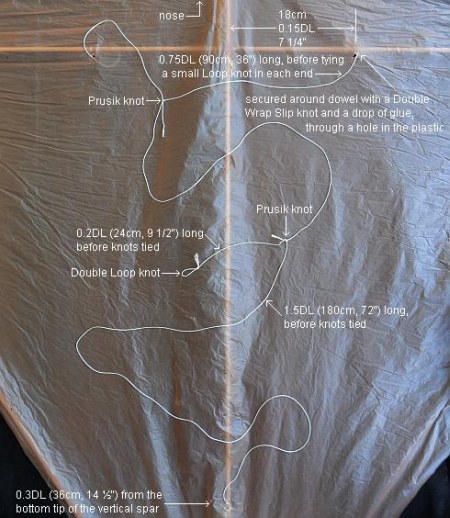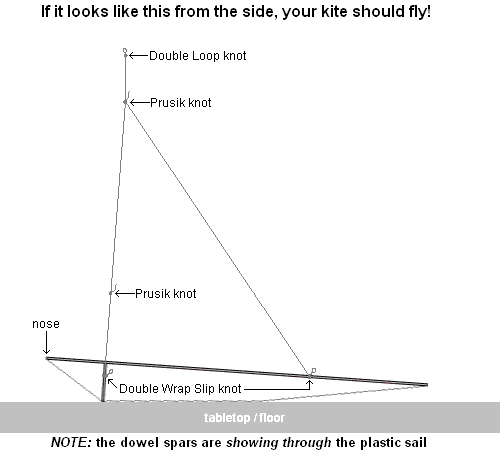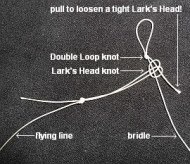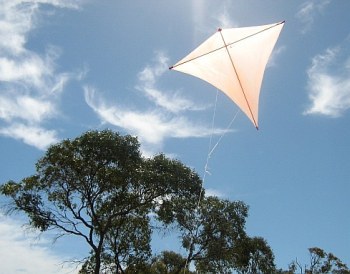- Home Page
- Better Kites
- ... Diamond Kite
How to Make a Diamond Kite
Step by Step — Page 3 of 3
The MBK Dowel Diamond
How to Make a Diamond Kite
The Bridle
Dacron line in 50-pound strength is ideal for these Dowel Series kites.
All the construction details for the bridle are contained in the large photo below. But to summarize:
- At the top of the photo there is a 90 cm (36 in.) length of line tied to the horizontal spar at left and right.
- One end of a 180 cm (72 in.) line is tied to the middle of the 90 cm (36 in.) line with a Prusik knot.
- The other end of the 180 cm (72 in.) line is tied to the vertical spar; see the bottom of the photo.
- Finally, the 24 cm (9 1/2 in.) line is tied to the middle of the 180 cm (72 in.) line with a Prusik knot but will need to be slipped upward until the bridle looks like the side view in the diagram below the photo.
KNOTS
If you are new to this, you might need instructions on how to tie the following knots:
Loop Knot
Double-Wrap Slip Knot
Prusik Knot
TIP: Secure the slip knots onto the dowels with enough wood glue to ensure the knots can never slip along the dowel. They won't loosen either.

ADJUSTMENT
Once your kite and bridle looks like the photo up there:
Hold the short bridle line up so all the bridle lines are straight, with the kite laying flat on the table or floor.
Make sure the Prusik knot closest to the kite is adjusted to the middle, right over the vertical spar.
Referring to the diagram below, shift the other Prusik knot to the shown position. It's not necessarily the perfect position for your individual kite, but it should at least fly on the first attempt! Later, you can experiment with shifting the position toward or away from the nose, a little at a time, to improve how high your kite flies.

How to Make a Diamond Kite
Attaching the Flying Line

Make up a flying line and attach it to the bridle with a Lark's Head knot. See the photo, where the Lark's Head has been left loose.
Now, drop the rigged kite so it floats face-down toward the floor. If it tends to drop its nose and glide forward, add weight near the bottom corner of the sail until the gliding stops. For example, wrap some extra tape around the vertical spar near the tail end.
How to Make a Diamond Kite
Flying!

First, if it's very windy outside, stay home! This is a light-wind kite and won't like being launched in a gale. The picture shows the original Dowel Diamond on its first outing, hovering at around treetop height in a dying late-evening breeze.
The Prusik knot on the bridle line can loosen off a little over time. If necessary, pull on all the lines to tighten the knot up before a flying session.
Assuming there is some breeze outside, just dangle the kite at arm's length until the wind catches it. As long as you feel the kite pulling, let out line slowly by taking loop after loop off the winder. Be cautious about letting line slip through your fingers. If a big gust hits the kite, the line could burn you! For any kite this big or bigger, it's a good idea to wear a cloth glove.
Out in the Field
Diamond-kite stories of my real-life flying experiences are worth checking out!
Illustrated with photos and videos, of course.
Another approach is to get a helper to hold the kite up and let it go, on the end of maybe 15 meters (50 feet) of line. This way, the kite soon gets high enough to make it easy to let more line out.
Have fun flying, and I hope you've enjoyed learning how to make a diamond kite!
Now, just in case you have actually made and flown this kite at least once already:
Flight Reports From Other Visitors
Click below to read about various kite-flying adventures, contributed by other visitors to this page...
Pair of Diamonds
So over the years I’ve made a few of Tim’s easy to follow plans. A dowel Rok, Box, Dopero, several skewer kites and recently a soft sled.
These were …
Winter Kite Build
First kite I've made in 50 years, my last one was made from news paper and small flat pine sticks. I have to admit this one is much better.
First flight …
Trash Bag Kite in the Sky
I have made this type of kite for my son using your instructions. Must say these are really well-written instructions, with links to helpful knot tying …
Very Satisfying First My-Best-Kite Experience!
Just made my first MBK kite - the Dowel Diamond - and I absolutely LOVE it!
Used a super light trash bag and got the kite up in almost no wind. It is …
Fantastic!
G'day. I had a go at making this kite - and did it turn out well! Members of my family, and friends were skeptical of my kite making because often my home-made …
Quick Kite Project
I attempted to make my own kite without reading any directions and failed miserably.
I made a quick and dirty version of the MBK Dowel Diamond kite …
As mentioned earlier, there's more kite making on this site than you can poke a stick at. :-)
Want to know the most convenient way of using it all?
The Big MBK E-book Bundle is a collection of downloads—printable PDF files which provide step-by-step instructions for many kites large and small.
That's every kite in every MBK series.
